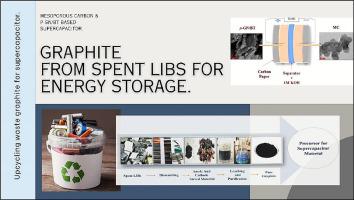当前位置:
X-MOL 学术
›
Appl. Energy
›
论文详情
Our official English website, www.x-mol.net, welcomes your feedback! (Note: you will need to create a separate account there.)
Upcycling waste graphite from spent LIBs for fabrication of novel mesoporous carbon and p-GN/BT based supercapacitor
Applied Energy ( IF 11.2 ) Pub Date : 2024-04-15 , DOI: 10.1016/j.apenergy.2024.123220 Roshan P. Rane , Shivam S. Shitole , Satyavan P. Varande , Bhavesh M. Patil , Paresh M. Patil , Vasant M. Patil , Atul C. Chaskar , Sunil N. Peshane , Vishwanath R. Patil
Applied Energy ( IF 11.2 ) Pub Date : 2024-04-15 , DOI: 10.1016/j.apenergy.2024.123220 Roshan P. Rane , Shivam S. Shitole , Satyavan P. Varande , Bhavesh M. Patil , Paresh M. Patil , Vasant M. Patil , Atul C. Chaskar , Sunil N. Peshane , Vishwanath R. Patil

|
Lithium-ion batteries (LIBs) are rapidly gaining popularity around the world, and this trend is certain to continue. As a result of increased use, more end-of-use LIBs are discarded in landfills without recycling. Innovative LIB recycling methods are emerging to solve the simultaneous challenges of increasing waste and the need for environmentally friendly energy storage. Graphite, a fundamental LIB component, has long been underestimated in terms of its potential for upcycling. This study investigates into the potential of recycling graphite sourced from spent LIB as precursor for economical synthesis of P-doped graphene/BaTiO (-GN/BT) and Mesoporous Carbon (MC). These materials are being investigated for their application in the efficient manufacturing of high-performance supercapacitor, showcasing transformative capability of graphite. Waste graphite recovered from LIB recycling is chemically treated to remove impurities and create a porous structure, which is subsequently utilized in forming the supercapacitor components. The supercapacitor has an outstanding specific capacitance of 150 F.g at a current density of 1.0 A. g. The power density, measured at 3260 W.kg, and the energy density, measured at 83.3 Wh.kg, are both substantially higher. Due to its exceptional cyclic stability, it can endure 10,000 charging and discharging cycles with negligible decline in performance. The findings indicate that the upcycling of graphite from retired LIBs may be a viable source for the construction of high-efficiency supercapacitors. This not only offers an eco-friendly energy storage solution, but also promises cost savings and increased profitability in recycling efforts.
中文翻译:

从废锂离子电池中回收废弃石墨,用于制造新型介孔碳和 p-GN/BT 超级电容器
锂离子电池(LIB)在世界范围内迅速普及,而且这种趋势肯定会持续下去。由于使用量的增加,更多的使用结束的锂离子电池被丢弃在垃圾填埋场而不进行回收。创新的锂离子电池回收方法不断涌现,以解决废物增加和环保能源存储需求同时面临的挑战。石墨作为锂离子电池的基本成分,其升级回收潜力长期以来一直被低估。本研究探讨了回收废锂离子电池中的石墨作为经济合成磷掺杂石墨烯/BaTiO (-GN/BT) 和介孔碳 (MC) 前体的潜力。人们正在研究这些材料在高性能超级电容器的高效制造中的应用,展示石墨的变革能力。从锂离子电池回收中回收的废石墨经过化学处理,以去除杂质并形成多孔结构,随后用于形成超级电容器组件。该超级电容器在电流密度为 1.0 A. g 时具有 150 Fg 的出色比电容。测得的功率密度为 3260 W.kg,测得的能量密度为 83.3 Wh.kg,均要高得多。由于其卓越的循环稳定性,它可以承受 10,000 次充电和放电循环,性能下降可以忽略不计。研究结果表明,从退役锂离子电池中回收石墨可能是构建高效超级电容器的可行来源。这不仅提供了一种环保的能源存储解决方案,而且还有望节省成本并提高回收工作的盈利能力。
更新日期:2024-04-15
中文翻译:

从废锂离子电池中回收废弃石墨,用于制造新型介孔碳和 p-GN/BT 超级电容器
锂离子电池(LIB)在世界范围内迅速普及,而且这种趋势肯定会持续下去。由于使用量的增加,更多的使用结束的锂离子电池被丢弃在垃圾填埋场而不进行回收。创新的锂离子电池回收方法不断涌现,以解决废物增加和环保能源存储需求同时面临的挑战。石墨作为锂离子电池的基本成分,其升级回收潜力长期以来一直被低估。本研究探讨了回收废锂离子电池中的石墨作为经济合成磷掺杂石墨烯/BaTiO (-GN/BT) 和介孔碳 (MC) 前体的潜力。人们正在研究这些材料在高性能超级电容器的高效制造中的应用,展示石墨的变革能力。从锂离子电池回收中回收的废石墨经过化学处理,以去除杂质并形成多孔结构,随后用于形成超级电容器组件。该超级电容器在电流密度为 1.0 A. g 时具有 150 Fg 的出色比电容。测得的功率密度为 3260 W.kg,测得的能量密度为 83.3 Wh.kg,均要高得多。由于其卓越的循环稳定性,它可以承受 10,000 次充电和放电循环,性能下降可以忽略不计。研究结果表明,从退役锂离子电池中回收石墨可能是构建高效超级电容器的可行来源。这不仅提供了一种环保的能源存储解决方案,而且还有望节省成本并提高回收工作的盈利能力。



























 京公网安备 11010802027423号
京公网安备 11010802027423号